GMC SIERRA 2007 Owner's Manual
Manufacturer: GMC, Model Year: 2007, Model line: SIERRA, Model: GMC SIERRA 2007Pages: 680, PDF Size: 3.42 MB
Page 431 of 680
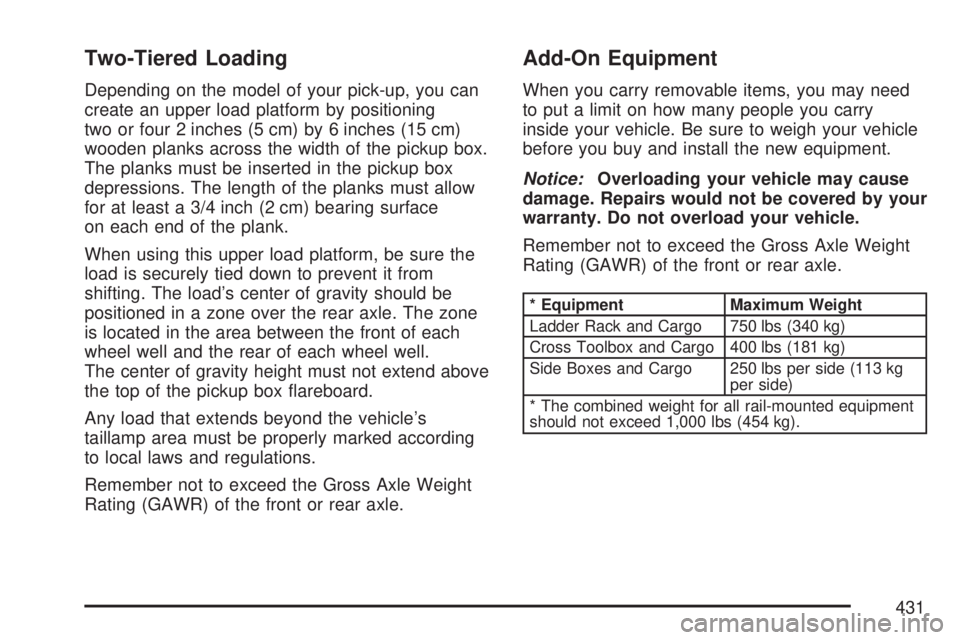
Two-Tiered Loading
Depending on the model of your pick-up, you can
create an upper load platform by positioning
two or four 2 inches (5 cm) by 6 inches (15 cm)
wooden planks across the width of the pickup box.
The planks must be inserted in the pickup box
depressions. The length of the planks must allow
for at least a 3/4 inch (2 cm) bearing surface
on each end of the plank.
When using this upper load platform, be sure the
load is securely tied down to prevent it from
shifting. The load’s center of gravity should be
positioned in a zone over the rear axle. The zone
is located in the area between the front of each
wheel well and the rear of each wheel well.
The center of gravity height must not extend above
the top of the pickup box �areboard.
Any load that extends beyond the vehicle’s
taillamp area must be properly marked according
to local laws and regulations.
Remember not to exceed the Gross Axle Weight
Rating (GAWR) of the front or rear axle.
Add-On Equipment
When you carry removable items, you may need
to put a limit on how many people you carry
inside your vehicle. Be sure to weigh your vehicle
before you buy and install the new equipment.
Notice:Overloading your vehicle may cause
damage. Repairs would not be covered by your
warranty. Do not overload your vehicle.
Remember not to exceed the Gross Axle Weight
Rating (GAWR) of the front or rear axle.
* Equipment Maximum Weight
Ladder Rack and Cargo 750 lbs (340 kg)
Cross Toolbox and Cargo 400 lbs (181 kg)
Side Boxes and Cargo 250 lbs per side (113 kg
per side)
* The combined weight for all rail-mounted equipment
should not exceed 1,000 lbs (454 kg).
431
Page 432 of 680
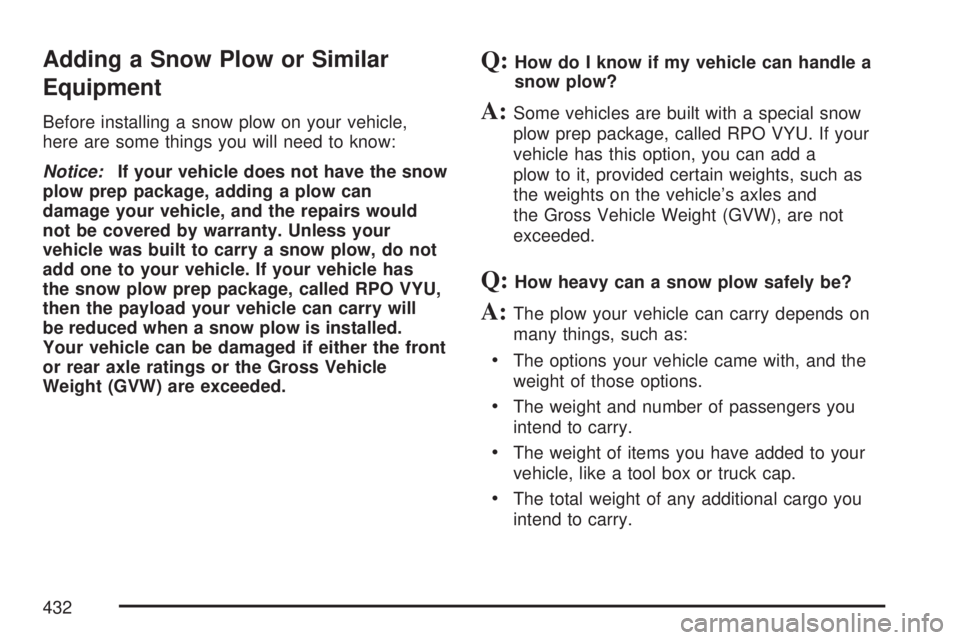
Adding a Snow Plow or Similar
Equipment
Before installing a snow plow on your vehicle,
here are some things you will need to know:
Notice:If your vehicle does not have the snow
plow prep package, adding a plow can
damage your vehicle, and the repairs would
not be covered by warranty. Unless your
vehicle was built to carry a snow plow, do not
add one to your vehicle. If your vehicle has
the snow plow prep package, called RPO VYU,
then the payload your vehicle can carry will
be reduced when a snow plow is installed.
Your vehicle can be damaged if either the front
or rear axle ratings or the Gross Vehicle
Weight (GVW) are exceeded.
Q:How do I know if my vehicle can handle a
snow plow?
A:Some vehicles are built with a special snow
plow prep package, called RPO VYU. If your
vehicle has this option, you can add a
plow to it, provided certain weights, such as
the weights on the vehicle’s axles and
the Gross Vehicle Weight (GVW), are not
exceeded.
Q:How heavy can a snow plow safely be?
A:The plow your vehicle can carry depends on
many things, such as:
The options your vehicle came with, and the
weight of those options.
The weight and number of passengers you
intend to carry.
The weight of items you have added to your
vehicle, like a tool box or truck cap.
The total weight of any additional cargo you
intend to carry.
432
Page 433 of 680
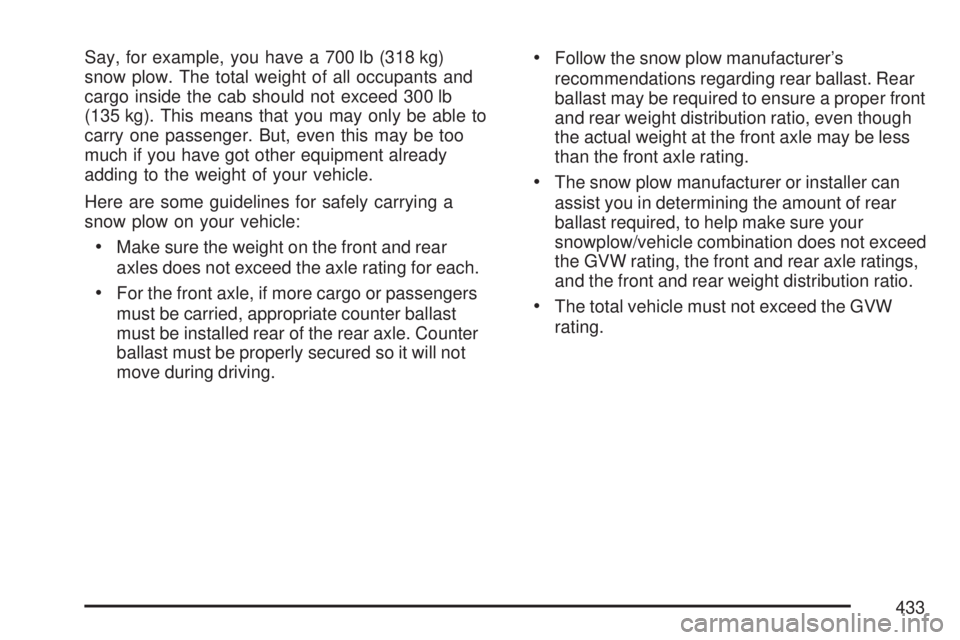
Say, for example, you have a 700 lb (318 kg)
snow plow. The total weight of all occupants and
cargo inside the cab should not exceed 300 lb
(135 kg). This means that you may only be able to
carry one passenger. But, even this may be too
much if you have got other equipment already
adding to the weight of your vehicle.
Here are some guidelines for safely carrying a
snow plow on your vehicle:
Make sure the weight on the front and rear
axles does not exceed the axle rating for each.
For the front axle, if more cargo or passengers
must be carried, appropriate counter ballast
must be installed rear of the rear axle. Counter
ballast must be properly secured so it will not
move during driving.
Follow the snow plow manufacturer’s
recommendations regarding rear ballast. Rear
ballast may be required to ensure a proper front
and rear weight distribution ratio, even though
the actual weight at the front axle may be less
than the front axle rating.
The snow plow manufacturer or installer can
assist you in determining the amount of rear
ballast required, to help make sure your
snowplow/vehicle combination does not exceed
the GVW rating, the front and rear axle ratings,
and the front and rear weight distribution ratio.
The total vehicle must not exceed the GVW
rating.
433
Page 434 of 680
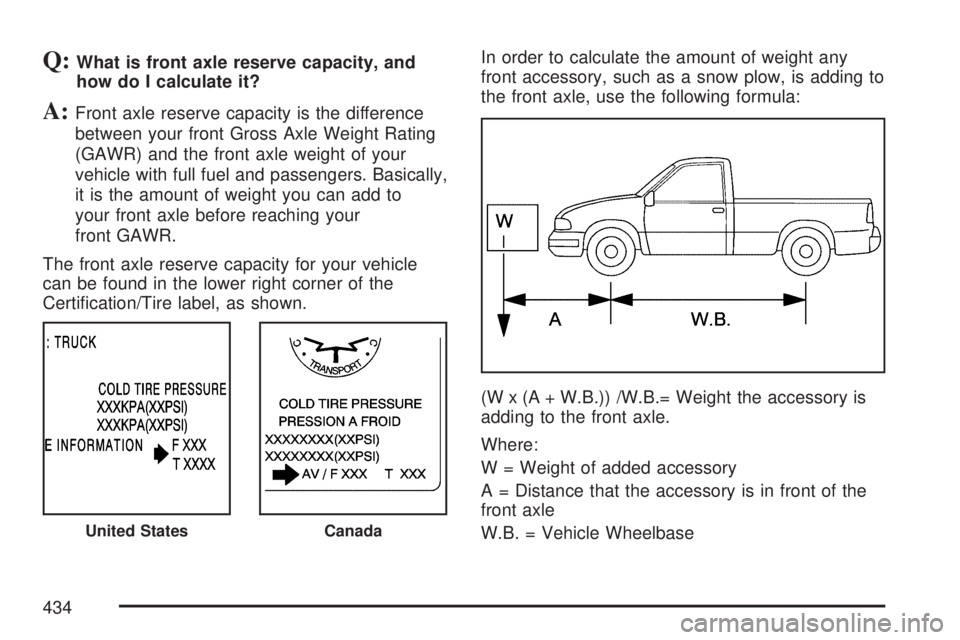
Q:What is front axle reserve capacity, and
how do I calculate it?
A:Front axle reserve capacity is the difference
between your front Gross Axle Weight Rating
(GAWR) and the front axle weight of your
vehicle with full fuel and passengers. Basically,
it is the amount of weight you can add to
your front axle before reaching your
front GAWR.
The front axle reserve capacity for your vehicle
can be found in the lower right corner of the
Certi�cation/Tire label, as shown.In order to calculate the amount of weight any
front accessory, such as a snow plow, is adding to
the front axle, use the following formula:
(W x (A + W.B.)) /W.B.= Weight the accessory is
adding to the front axle.
Where:
W = Weight of added accessory
A = Distance that the accessory is in front of the
front axle
W.B. = Vehicle Wheelbase
United StatesCanada
434
Page 435 of 680
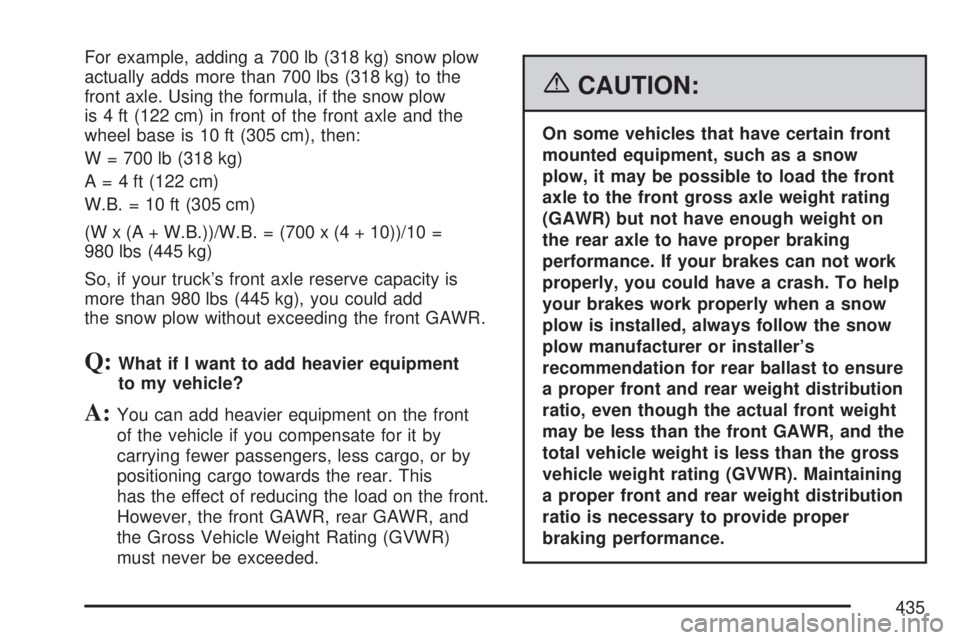
For example, adding a 700 lb (318 kg) snow plow
actually adds more than 700 lbs (318 kg) to the
front axle. Using the formula, if the snow plow
is 4 ft (122 cm) in front of the front axle and the
wheel base is 10 ft (305 cm), then:
W = 700 lb (318 kg)
A = 4 ft (122 cm)
W.B. = 10 ft (305 cm)
(W x (A + W.B.))/W.B. = (700 x (4 + 10))/10 =
980 lbs (445 kg)
So, if your truck’s front axle reserve capacity is
more than 980 lbs (445 kg), you could add
the snow plow without exceeding the front GAWR.
Q:What if I want to add heavier equipment
to my vehicle?
A:You can add heavier equipment on the front
of the vehicle if you compensate for it by
carrying fewer passengers, less cargo, or by
positioning cargo towards the rear. This
has the effect of reducing the load on the front.
However, the front GAWR, rear GAWR, and
the Gross Vehicle Weight Rating (GVWR)
must never be exceeded.
{CAUTION:
On some vehicles that have certain front
mounted equipment, such as a snow
plow, it may be possible to load the front
axle to the front gross axle weight rating
(GAWR) but not have enough weight on
the rear axle to have proper braking
performance. If your brakes can not work
properly, you could have a crash. To help
your brakes work properly when a snow
plow is installed, always follow the snow
plow manufacturer or installer’s
recommendation for rear ballast to ensure
a proper front and rear weight distribution
ratio, even though the actual front weight
may be less than the front GAWR, and the
total vehicle weight is less than the gross
vehicle weight rating (GVWR). Maintaining
a proper front and rear weight distribution
ratio is necessary to provide proper
braking performance.
435
Page 436 of 680
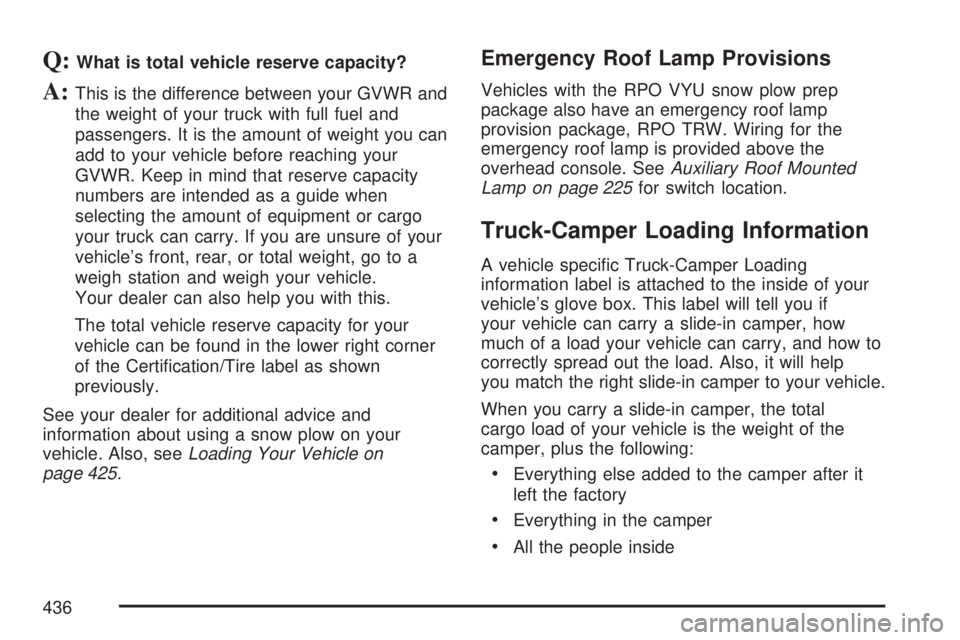
Q:What is total vehicle reserve capacity?
A:This is the difference between your GVWR and
the weight of your truck with full fuel and
passengers. It is the amount of weight you can
add to your vehicle before reaching your
GVWR. Keep in mind that reserve capacity
numbers are intended as a guide when
selecting the amount of equipment or cargo
your truck can carry. If you are unsure of your
vehicle’s front, rear, or total weight, go to a
weigh station and weigh your vehicle.
Your dealer can also help you with this.
The total vehicle reserve capacity for your
vehicle can be found in the lower right corner
of the Certi�cation/Tire label as shown
previously.
See your dealer for additional advice and
information about using a snow plow on your
vehicle. Also, seeLoading Your Vehicle on
page 425.
Emergency Roof Lamp Provisions
Vehicles with the RPO VYU snow plow prep
package also have an emergency roof lamp
provision package, RPO TRW. Wiring for the
emergency roof lamp is provided above the
overhead console. SeeAuxiliary Roof Mounted
Lamp on page 225for switch location.
Truck-Camper Loading Information
A vehicle speci�c Truck-Camper Loading
information label is attached to the inside of your
vehicle’s glove box. This label will tell you if
your vehicle can carry a slide-in camper, how
much of a load your vehicle can carry, and how to
correctly spread out the load. Also, it will help
you match the right slide-in camper to your vehicle.
When you carry a slide-in camper, the total
cargo load of your vehicle is the weight of the
camper, plus the following:
Everything else added to the camper after it
left the factory
Everything in the camper
All the people inside
436
Page 437 of 680
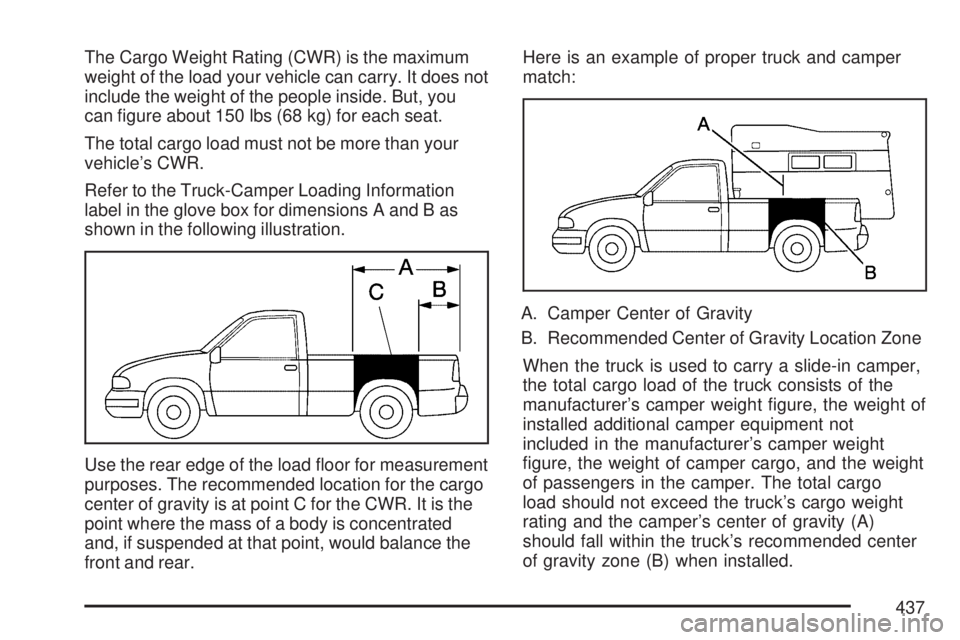
The Cargo Weight Rating (CWR) is the maximum
weight of the load your vehicle can carry. It does not
include the weight of the people inside. But, you
can �gure about 150 lbs (68 kg) for each seat.
The total cargo load must not be more than your
vehicle’s CWR.
Refer to the Truck-Camper Loading Information
label in the glove box for dimensions A and B as
shown in the following illustration.
Use the rear edge of the load �oor for measurement
purposes. The recommended location for the cargo
center of gravity is at point C for the CWR. It is the
point where the mass of a body is concentrated
and, if suspended at that point, would balance the
front and rear.Here is an example of proper truck and camper
match:
A. Camper Center of Gravity
B. Recommended Center of Gravity Location Zone
When the truck is used to carry a slide-in camper,
the total cargo load of the truck consists of the
manufacturer’s camper weight �gure, the weight of
installed additional camper equipment not
included in the manufacturer’s camper weight
�gure, the weight of camper cargo, and the weight
of passengers in the camper. The total cargo
load should not exceed the truck’s cargo weight
rating and the camper’s center of gravity (A)
should fall within the truck’s recommended center
of gravity zone (B) when installed.
437
Page 438 of 680
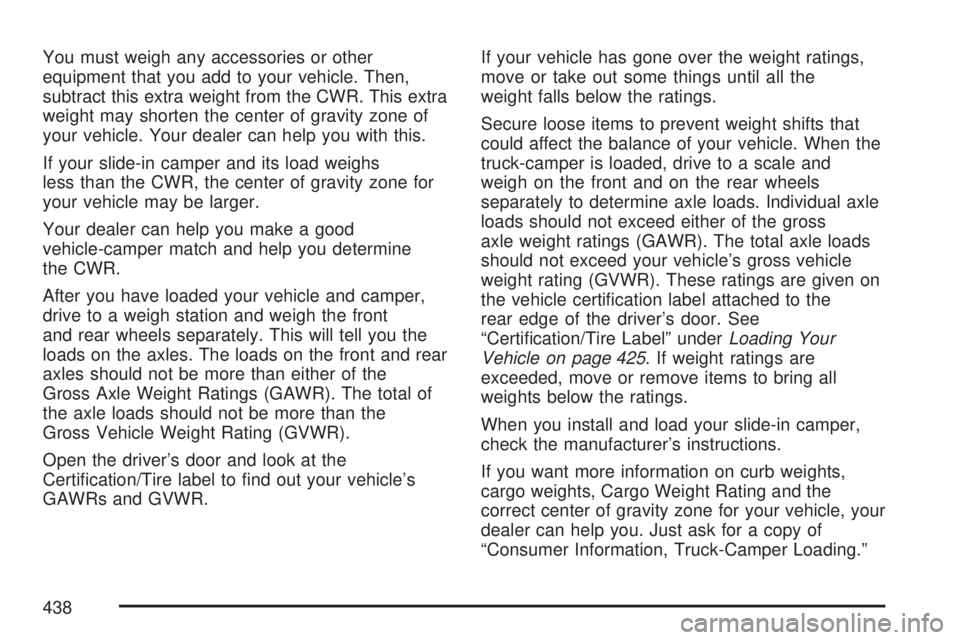
You must weigh any accessories or other
equipment that you add to your vehicle. Then,
subtract this extra weight from the CWR. This extra
weight may shorten the center of gravity zone of
your vehicle. Your dealer can help you with this.
If your slide-in camper and its load weighs
less than the CWR, the center of gravity zone for
your vehicle may be larger.
Your dealer can help you make a good
vehicle-camper match and help you determine
the CWR.
After you have loaded your vehicle and camper,
drive to a weigh station and weigh the front
and rear wheels separately. This will tell you the
loads on the axles. The loads on the front and rear
axles should not be more than either of the
Gross Axle Weight Ratings (GAWR). The total of
the axle loads should not be more than the
Gross Vehicle Weight Rating (GVWR).
Open the driver’s door and look at the
Certi�cation/Tire label to �nd out your vehicle’s
GAWRs and GVWR.If your vehicle has gone over the weight ratings,
move or take out some things until all the
weight falls below the ratings.
Secure loose items to prevent weight shifts that
could affect the balance of your vehicle. When the
truck-camper is loaded, drive to a scale and
weigh on the front and on the rear wheels
separately to determine axle loads. Individual axle
loads should not exceed either of the gross
axle weight ratings (GAWR). The total axle loads
should not exceed your vehicle’s gross vehicle
weight rating (GVWR). These ratings are given on
the vehicle certi�cation label attached to the
rear edge of the driver’s door. See
“Certi�cation/Tire Label” underLoading Your
Vehicle on page 425. If weight ratings are
exceeded, move or remove items to bring all
weights below the ratings.
When you install and load your slide-in camper,
check the manufacturer’s instructions.
If you want more information on curb weights,
cargo weights, Cargo Weight Rating and the
correct center of gravity zone for your vehicle, your
dealer can help you. Just ask for a copy of
“Consumer Information, Truck-Camper Loading.”
438
Page 439 of 680
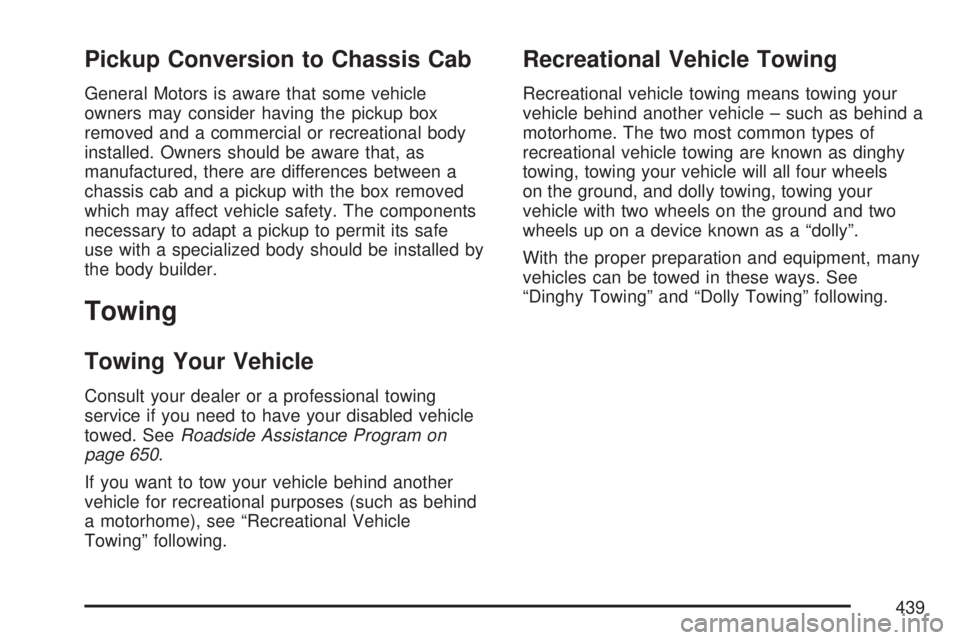
Pickup Conversion to Chassis Cab
General Motors is aware that some vehicle
owners may consider having the pickup box
removed and a commercial or recreational body
installed. Owners should be aware that, as
manufactured, there are differences between a
chassis cab and a pickup with the box removed
which may affect vehicle safety. The components
necessary to adapt a pickup to permit its safe
use with a specialized body should be installed by
the body builder.
Towing
Towing Your Vehicle
Consult your dealer or a professional towing
service if you need to have your disabled vehicle
towed. SeeRoadside Assistance Program on
page 650.
If you want to tow your vehicle behind another
vehicle for recreational purposes (such as behind
a motorhome), see “Recreational Vehicle
Towing” following.
Recreational Vehicle Towing
Recreational vehicle towing means towing your
vehicle behind another vehicle – such as behind a
motorhome. The two most common types of
recreational vehicle towing are known as dinghy
towing, towing your vehicle will all four wheels
on the ground, and dolly towing, towing your
vehicle with two wheels on the ground and two
wheels up on a device known as a “dolly”.
With the proper preparation and equipment, many
vehicles can be towed in these ways. See
“Dinghy Towing” and “Dolly Towing” following.
439
Page 440 of 680
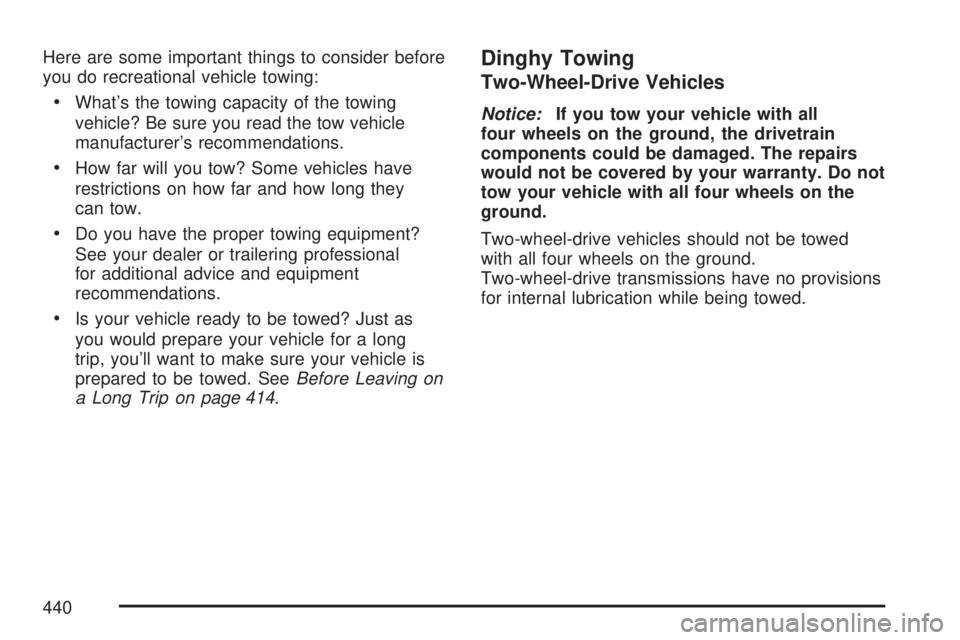
Here are some important things to consider before
you do recreational vehicle towing:
What’s the towing capacity of the towing
vehicle? Be sure you read the tow vehicle
manufacturer’s recommendations.
How far will you tow? Some vehicles have
restrictions on how far and how long they
can tow.
Do you have the proper towing equipment?
See your dealer or trailering professional
for additional advice and equipment
recommendations.
Is your vehicle ready to be towed? Just as
you would prepare your vehicle for a long
trip, you’ll want to make sure your vehicle is
prepared to be towed. SeeBefore Leaving on
a Long Trip on page 414.
Dinghy Towing
Two-Wheel-Drive Vehicles
Notice:If you tow your vehicle with all
four wheels on the ground, the drivetrain
components could be damaged. The repairs
would not be covered by your warranty. Do not
tow your vehicle with all four wheels on the
ground.
Two-wheel-drive vehicles should not be towed
with all four wheels on the ground.
Two-wheel-drive transmissions have no provisions
for internal lubrication while being towed.
440